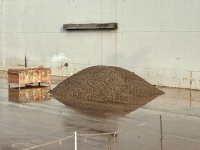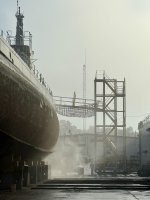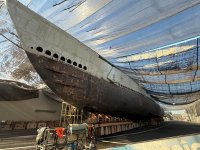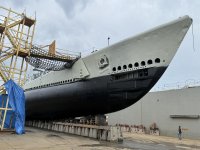Another USS Cobia Drydock update from Mark.



From this series you can easily see the amount of encrustation that gives the impression that USS Cobia's lower hull is mis shaped. The dreaded fresh water Zebra mussels and other marine life have grown prolifically since 1996.
The Fincantieri Yard Guys commented that they scraped and power washed almost 3 tons of marine growth from the Ol' Lady's hull.



Following cleaning of the lower hull, She didn't look too bad a'tall. Fresh water museum vessels lend themselves to a lot less electrolysis and corrosion than salt water museum vessels are prone to.
Priming and painting ensued, save the places where the hull blocks support USS Cobia in the floating drydock. They will flood the dock down, floating the Boat in place, shift the blocks, pump the dock out, set her back on the blocks, and refinish those spots before the drydock period is complete.
Mark also tells me the Museum has the #1 torpedo tube outer door, that was damaged by ice and the Fincantieri men will repair. paint and reinstall the outer door before USS Cobia returns to her berth in the Manitowoc river at the Wisconasin Maritime Museum.

For the metallurgists among us, this is the survey of the Boat's outer hull "mild steel" composition. One of the main reasons the US Navy removes the big bronze/brass screws of museum vessels is to prevent electrolysis between the the mild steel hull and the propellers. Another must be to keep overly enthusiastic vet's and volunteers from interdicting enemy shipping on Lake Michigan without proper COMSUBLANT permission.
"Can USS Cobia submerge?"
Well, yes and no. The after torpedo hatch is modified to easily accommodate visitors and well wishers. It is weathertight in a fashion but not watertight by any means. USS Cobia could submerge, but her ability to surface with the after torpedo room flooded is in doubt. Better to run on the surface than risk a mishap.
"If she still had her propellers, could USS Cobia sail under her own power?"
Volunteers have restored engines #1 and 2 of her 4 GM 16-248 V-16 engines to operation. It is unknown how well her dynamos and electric motors may function, so a theoretic "Maybe" is the answer to this question.
Of note, her original SJ-1 search radar and radio shack have been restored and are operational. The oldest operating General Electric SJ-1 radar set in the World AND Don'tcha wanna know how to work it?!
https://www.maritime.org/doc/radar/part4.php#pgSJ-1
Stay tuned friends, for more exciting World War II Submarine developments!


















